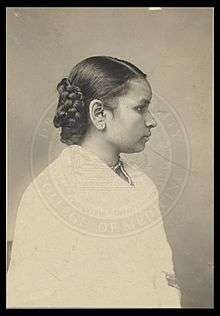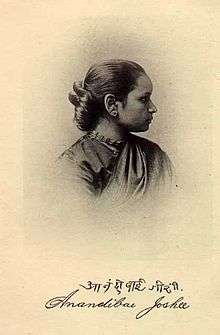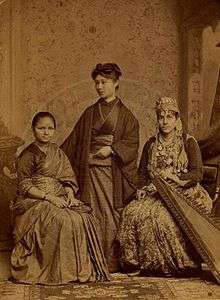Anandi Gopal Joshi
| Anandibai Joshi | |
|---|---|
 A portrait photo of Dr. Anandibai Joshee, M.D., Class of 1886. | |
| Born |
31 March 1865 Kalyan, Bombay Presidency, British India |
| Died |
26 February 1887 (aged 21) Pune, Bombay Presidency, British India |
| Resting place | Poughkeepsie, New York, United States (ashes) |
| Alma mater | Women's Medical College of Pennsylvania |
| Spouse(s) | Gopalrao Joshi |

Anandibai Gopalrao Joshi, MD (Marathi: आनंदीबाई गोपाळराव जोशी) (31 March 1865 – 26 February 1887) was one of the first South Asian female physicians while first Indian female physician, to be trained in the tradition of Western medicine was Kadambini Ganguly.[1][2] She was the first female of Indian origin to study and graduate with a degree in medicine in the United States . She is also believed to be the first Hindu woman to set foot on American soil.[3]
Early life
Anandibai was born as Yamuna, in Kalyan of the Thane district in present-day Maharashtra, to an orthodox Hindu family. Her family used to be landlords in Kalyan but lost their economic wealth. As was the practice at that time, Yamuna was married at the age of nine to Gopalrao Joshi, a widower almost twenty years her senior, due to pressure laid by her family. After marriage, her husband renamed her Anandi .
Gopalrao worked as a postal clerk in Kalyan. Later, he was transferred to Alibag, and then, finally, to Calcutta (today, Kolkata). He was a progressive thinker, and supported education for women, which was not very prevalent in India at the time.
It was common for Brahmins in those times to be proficient in Sanskrit. However, influenced by Lokhitawadi's Shat Patre, Gopalrao regarded learning English as more pragmatic than learning Sanskrit. Noticing Anandibai's interest, he helped her receive an education and learn English.
At the age of fourteen, Anandibai gave birth to a boy. But the child lived only for ten days because the medical care necessary for his survival was unavailable. This situation proved to be a turning point in Anandibai's life, and inspired her to become a physician.
Towards a medical career
Gopalrao encouraged Anandibai to study medicine. In 1880, he sent a letter to Royal Wilder, a well-known American missionary, stating Anandibai's interest in studying medicine in the United States, and inquiring about a suitable post in the US for himself . Wilder offered to help if the couple would convert to Christianity. This proposition, however, was not acceptable to the Joshi couple.
Wilder published the correspondence in his, Princeton's Missionary Review. Theodicia Carpenter, a resident of Roselle, New Jersey, happened to read it while waiting to see her dentist. Anandibai's desire to study medicine, and Gopalrao's support for his wife impressed her, and she wrote to them offering Anandibai accommodation in America. An exchange of many letters between Anandibai and Theodicia ensued in which they discussed, among other things, Hindu culture and religion.
While the Joshi couple was in Calcutta, Anandibai's health was declining. She suffered from weakness, constant headaches, occasional fever, and, sometimes, breathlessness. Theodicia sent her medicines from America, without results. In 1883, Gopalrao was transferred to Serampore, and he decided to send Anandibai by herself to America for her medical studies despite her poor health. Though apprehensive, Gopalrao convinced her to set an example for other women by pursuing higher education.
A physician couple named Thorborn suggested Anandibai to apply to the Women's Medical College of Pennsylvania. On learning of Anandibai's plans to pursue higher education in the West, orthodox Hindu society censured her very strongly. Many Christians supported her decision, but they wanted her to convert to Christianity.
Anandibai addressed the community at Serampore College Hall, explaining her decision to go to America and obtain a medical degree. She discussed the persecution she and her husband had endured. She stressed the need for Hindu female doctors in India, and talked about her goal of opening a medical college for women in India. She also pledged that she would not convert to Christianity. Her speech received publicity, and financial contributions started pouring in from all over India.
In America

Anandibai travelled to New York from Calcutta by ship, chaperoned by two English female acquaintances of the Thorborns. In New York, Theodicia Carpenter received her in June 1883. Anandibai wrote to the Women's Medical College of Pennsylvania, asking to be admitted to their medical program,[4] (which was the second women's medical program in the world). Rachel Bodley, the dean of the college, enrolled her.
Anandibai began her medical education at age 19. In America, her declining health worsened because of the cold weather, and unfamiliar diet. She contracted tuberculosis. Nevertheless, she graduated with an MD on 11 March 1886, the topic of her thesis was "Obstetrics among the Aryan Hindoos". On her graduation, Queen Victoria sent her a congratulatory message.
Return to India
In late 1886, Anandibai returned to India, receiving a hero's welcome. The princely state of Kolhapur appointed her as the physician-in-charge of the female ward of the local Albert Edward Hospital.
Death
Anandibai died early next year on 26 February 1887 before turning 22. Her death was mourned throughout India. Her ashes were sent to Theodicia Carpenter, who placed them in her family cemetery in Poughkeepsie, New York.
Biography
Caroline Wells Healey Dall wrote Anandibai's biography in 1888.[5]
Doordarshan aired a Hindi serial named "Anandi Gopal" based on Anandibai's life. (Kamlakar Sarang directed the serial.)
Shrikrishna Janardan Joshi wrote a fictionalised account of Anandabai 's life in his Marathi novel Anandi Gopal. (The novel has been translated in an abridged form in English by Asha Damle.) It has also been adapted into a play of the same name by Ram G. Joglekar.
Marathi writer Dr. Anjali Kirtane has done extensive research on the life of Dr. Anandibai Joshi and has written a Marathi book titled 'Dr. Anandibai Joshi, Kaal ani Kartutva' (meaning: Dr. Anandibai Joshi, her times and accomplishments) published by Majestic Prakashan, Mumbai. The book contains very rare photographs of Dr. Anandibai Joshi.
Legacy
The Institute for Research and Documentation in Social Sciences (IRDS), a non-governmental organisation from Lucknow, has been awarding the Anandibai Joshi Award for Medicine in reverence for her early contributions to the cause of advancing medical science in India.[6]
In addition, the Government of Maharashtra has established a fellowship in her name for young women working on women’s health.
References
- ↑ "First lady doctor of India". The Telegraph. Retrieved 2016-05-01.
- ↑ http://www.insa.nic.in/writereaddata/UpLoadedFiles/IJHS/Vol46_4_4_SKMajumdar.pdf
- ↑ "Historical Photos Depict Women Medical Pioneers". Public Radio International. 12 July 2013. Retrieved 29 October 2013.
- ↑ Scan of letter from Anandibai Joshi to Alfred Jones, 28 June 1883; DUCOM Archives
- ↑ The Life of Dr. Anandabai Joshee: A Kinswoman of the Pundita Ramabai, published by Roberts Brothers, Boston
- ↑ "IRDS Awards 2011". Irdsindia.com. Retrieved 29 October 2013.
Anandibai Joshi was one of the first Indian women to have obtained a degree in modern medicine when despite great hardships and poor health she got the MD from University of Pennsylvania in USA in the end of 19 th Century.
Bibliography
- Mrs. Caroline Healey Dall (1888). The Life of Dr. Anandabai Joshee. Roberts Brothers, Boston.
- Kosambi, Meera, "Caste and Outcast (review)". Journal of Colonialism and Colonial History – Volume 4, Number 1, Spring 2003, The Johns Hopkins University Press
- Anandibai Joshi: India’s first woman doctor (1865–1887)
- Between the Lines, an 18-minute English documentary on the life of Anandi Joshi
- Madhukar Vasudev Dhond, "Jalyatil Chandra" (Marathi) (Rajhans Prakashan, 1994)
- Documents at the Drexel University College of Medicine Archives and Special Collections on Women in Medicine and referencing Anandi Gopal Joshi
External links
| Wikimedia Commons has media related to Anandibai Gopalrao Joshee. |